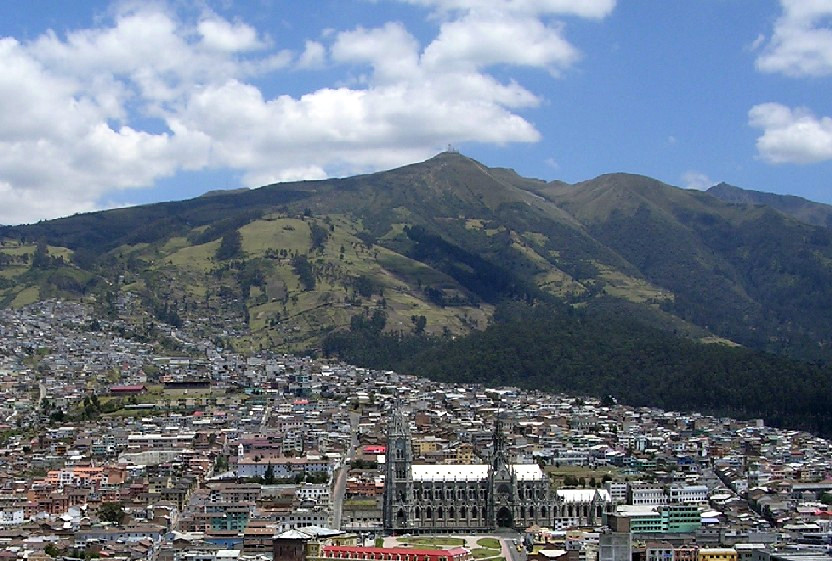New Year’s Day (January 1): On New Year’s Day, people still are
partying far into the early hours of the morning. The streets are quiet, a drastic change from the revelries
of the night before. Almost all of
the businesses are closed and few people are out. Of course, if I were out partying until the sun came up, I’d
crash too.
Maundy Thursday / Good Friday (varies): Special Maundy Thursday services are
held at church, and some people participate in the washing of the feet. People in Quito will often visit the
churches in the historical district.
A large colorful procession is the main event on Good Friday. Some people carry heavy crosses along
the way. A special Good Friday
mass in held, and people make a special meal made of 12 different grains and codfish
to signify the 12 disciples of Jesus. While many countries view Holy Saturday with graveness,
Ecuador approaches it as a day of glorious celebration. Easter is also a day of
celebration, beginning with services at church and following with a special
luncheon and hunting for Easter eggs.
 |
| Sorry, but the pointy hoods are creepy. Like a purple KKK. With abs. |
International Worker’s Day (May 1): This day celebrates the worker and is
often used as a day for addressing current labor issues and labor
achievements. Ecuador has about
123,000 refugees from Colombia, escaping the violence in that country. It’s also a stop in the drug
trafficking trade, and there are some reports of child labor, forced labor, and
human trafficking.
The Battle of Pichincha (May 24): This battle was
the last battle that took place when Ecuador was fighting for its independence
from Spain. It happened on a
volcano called Pichincha, about 3500 meters (11500 feet) above sea level. School kids will often participate in
local parades and sometimes the military joins in as well. The kids with the highest grades will
often carry the flag during the procession. This holiday tends to be centered around celebrating
Ecuador’s history and displaying national pride.
The Birthday of Simón Bolívar (July 24): Simón
Bolívar is the military leader who is the one responsible for winning the
independence for not only Ecuador, but also for Venezuela, Panama, Colombia,
Bolivia, and Peru. He’s often
characterized as a national hero. There are often military parades and school
parades with brightly colored traditional wear, complete with brass bands and dancing
and waving flags.
Declaration of Independence of Quito (August 10): Quito is where the independence for
their country started. This was the day when people decided enough was
enough. It came at a time when
Napoleon had invaded Spain and overtook the throne. Ecuadorians more of less
took advantage of Spain’s instability, and over the next year, there were
several battles, but eventually they did officially declare their
independence. Generally, the
celebrations last most of the month of August, and include music concerts,
parades, cultural displays, and local festivals.
 |
| Guayaquil |
Independence of Guayaquil (October 9): This is the
day that a group of patriots in Guayaquil overtook a military base just after
midnight and detained some of the high-level commanders until dawn and then
signed their declaration of independence.
Guayaquil is now a center for arts and culture and nicknamed “The Pearl
of the Pacific.” The city pretty
much has a citywide party and everyone’s invited!
Flag Day (October 31): This is a day in honor of
the Ecuadorian flag. Flags are
displayed from people’s homes and businesses all around.
All Soul’s Day (November 2): This holiday blends
religious beliefs with traditional beliefs. It’s kind of similar to the Day of the Dead festival that
takes place in other Latin countries where people honor those who have passed
on before us. It’s a common day to
visit graves, do any maintenance, refresh flowers, etc. One tradition is to make a sweet bread
called guaguas de pan, or bread babies (which we will be making later). These pieces of bread are shaped like a
swaddled baby and decorated with icing.
It’s almost always accompanied by a purple drink called colada. It’s like a smoothie mix of various
fruits and sometimes sweet peppers and a variety of other ingredients. (I’m attempting to make this as well).
Independence of Cuenca (November 3): Primarily
celebrated in Cuenca, this holiday celebrates the declaration of independence
by the City of Cuenca. Basically,
the whole town shuts down and has one big party. Schools and business close, music and dancing fill the
streets, local food vendors serve savory treats, and arts and crafts are
displayed and sold.
Foundation of Quito (December 6): Also known as Fiestas de Quito, it’s a week-long
party celebrating the founding of the city of Quito. There are many activities and events going on all week,
ending on December 6. Some of the
common festivities and events include bullfighting, parades, music concerts,
block parties, flamenco dancing, marching bands, fireworks, and many people
ride what’s called a Chiva, which is kind of an open bus with a band.
Christmas Day (December 25): Christmas in Ecuador
is a month-long celebration. Nativity scenes are put up everywhere. Many people take part in novenas: public
gatherings of prayers, hymns, and poetry, and it’s followed by hot chocolate
and cookies (yes, hot chocolate in summer). Christmas Eve is usually spent having an elaborate dinner
with family, complete with stuffed turkey or chicken, rice with cheese, salads,
local fruits, and of course wine.
Parents usually leave the children’s presents at the foot of their beds,
and Christmas Day is spent giving gifts with family and friends.
New Year’s Eve (December 31): One tradition in Ecuador on New Year’s
Eve is to get rid of the bad things. Some people will make scarecrow-like dolls
in the likeness of people they don’t like (I have a few in mind) or notable
people, and then at the stroke of midnight, everyone burns them. Another tradition some men do is to
dress up like women and beg for beer money. (Kids will also dress up and beg for candy.) Beer is a must-have for any New Year’s
festivities. Many people wear
masks and attend parties, some of them held as street parties – and of course,
fireworks are lit off at midnight.
Up next: art and literature





No comments:
Post a Comment